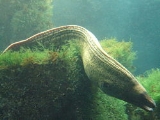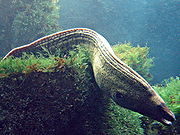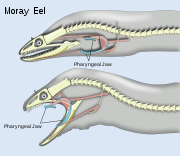
Mediterranean moray
Encyclopedia
The Mediterranean moray (sometimes also called Roman eel, Muraena helena) is a fish of the moray eel
family. It has a long eel-like body and is found in the eastern Atlantic Ocean and Mediterranean Sea. Its bite can be dangerous to humans.
 The Mediterranean moray has an elongated, eel-like body and can reach a length of 1.5 meters and weigh over 15 kilograms. Its coloration varies from dark grey to dark brown with fine dark spots. The skin is slimy and without scales. The dorsal fin begins behind its head and continues to the caudal fin (fused with the anal fin). Pectoral fins are absent, teeth are long and sharp-pointed (like other morays), the mouth is long and robust and reaches behind the gill
The Mediterranean moray has an elongated, eel-like body and can reach a length of 1.5 meters and weigh over 15 kilograms. Its coloration varies from dark grey to dark brown with fine dark spots. The skin is slimy and without scales. The dorsal fin begins behind its head and continues to the caudal fin (fused with the anal fin). Pectoral fins are absent, teeth are long and sharp-pointed (like other morays), the mouth is long and robust and reaches behind the gill
s.
 The Mediterranean moray is known for its ‘alien’-like pharyngeal jaw. A pharyngeal jaw works like a second jaw. The moray first bites into its prey with their first set of teeth then the pharyngeal jaw/teeth come forward. It is like a two-bone hook structure (as shown in the picture at website http://www.nytimes.com/2007/09/11/science/11eel.html?_r=1&ref=science&pagewanted=all&oref=slogin). It grabs the prey and drags it towards its oesophagus for swallowing. This is the only animal known to do so. The Mediterranean moray’s pharyngeal jaw is homologous to the jaws of many other ray-finned fish, for example, a parrot fish, which use their pharyngeal jaw for grinding their food. Scientists believe they came to have these ‘alien’-like jaws from being in tight spaces where the suction technique used by many other fish is not ideal. It also helps when trying to eat prey larger than itself. The Mediterranean moray used to have front fins. In the absence of these it is believed the muscles which used to support them now support the movement of the pharyngeal jaw. Other muscles still have the same attachments as those of other ray-finned fish like the parrot fish but which have become larger and longer.
The Mediterranean moray is known for its ‘alien’-like pharyngeal jaw. A pharyngeal jaw works like a second jaw. The moray first bites into its prey with their first set of teeth then the pharyngeal jaw/teeth come forward. It is like a two-bone hook structure (as shown in the picture at website http://www.nytimes.com/2007/09/11/science/11eel.html?_r=1&ref=science&pagewanted=all&oref=slogin). It grabs the prey and drags it towards its oesophagus for swallowing. This is the only animal known to do so. The Mediterranean moray’s pharyngeal jaw is homologous to the jaws of many other ray-finned fish, for example, a parrot fish, which use their pharyngeal jaw for grinding their food. Scientists believe they came to have these ‘alien’-like jaws from being in tight spaces where the suction technique used by many other fish is not ideal. It also helps when trying to eat prey larger than itself. The Mediterranean moray used to have front fins. In the absence of these it is believed the muscles which used to support them now support the movement of the pharyngeal jaw. Other muscles still have the same attachments as those of other ray-finned fish like the parrot fish but which have become larger and longer.
to the coast of Senegal
; the waters of the Canary Islands
and the Azores
; and the Mediterranean Sea. It prefers rocky bottoms and lives in depths of from five to 80 meters. It is a solitary and territorial
species. The Mediterranean moray spends most of the day in cavities and clefts between rocks and is more active at night. It hunts fishes, crayfishes and cephalopods, but also feeds on dead animals.
The Mediterranean moray's reproduction is not well known. They spawn about 60,000 eggs into open water, from which planktonic transparent leptocephali
hatch.
One parasitic crustacean
, the trematode Folliculovarium mediterraneum and the flatworm
Lecithochirium grandiporum are parasites of the Mediterranean moray.
Moray eel
Moray eels are cosmopolitan eels of the family Muraenidae. The approximately 200 species in 15 genera are almost exclusively marine, but several species are regularly seen in brackish water and a few, for example the freshwater moray can sometimes be found in freshwater...
family. It has a long eel-like body and is found in the eastern Atlantic Ocean and Mediterranean Sea. Its bite can be dangerous to humans.
Appearance and characteristics

Gill
A gill is a respiratory organ found in many aquatic organisms that extracts dissolved oxygen from water, afterward excreting carbon dioxide. The gills of some species such as hermit crabs have adapted to allow respiration on land provided they are kept moist...
s.
Homologous feature

Analogous feature
Although snakes and Mediterranean morays are not closely related, the body of the Mediterranean moray is analogous to that of a snake. It is structured differently but serves the same function. Their bodies of both are flexible for folding or coiling into small places, for example, crevices for the Mediterranean moray and under rocks for the snake. Both also use their bodies to slither from place to place whether it be in the water or on land. The pharyngeal jaw of the Mediterranean moray (which is explained above) is also analogous to the snake’s jaw. The right and left jaw of the snake unattach allowing the snake to eat larger pray than itself successfully. The pharyngeal jaw of the Mediterranean moray uses a different method and has a different structure than the snake's but the outcome, purpose and advantage are the same. These analogous features have evolved independently of each other as both animals have adapted to their environment.Phylogeny
The closest relatives to the Mediterranean Moray are the many other species of morays. They are also closely related to bone fish, tarpon, ladyfish and saxpharynx fish. People commonly think that the electric eel and the Mediterranean moray must be very similar but in fact bony tongues , butterfly fish, elephant fish and featherbacks are closer on the tree of life. The electric eel and the Mediterranean moray do not show any relation until you go right back to its phylum, Chordata.Ecology
The Mediterranean moray inhabits the coastal waters of the eastern Atlantic Ocean from the British IslesBritish Isles
The British Isles are a group of islands off the northwest coast of continental Europe that include the islands of Great Britain and Ireland and over six thousand smaller isles. There are two sovereign states located on the islands: the United Kingdom of Great Britain and Northern Ireland and...
to the coast of Senegal
Senegal
Senegal , officially the Republic of Senegal , is a country in western Africa. It owes its name to the Sénégal River that borders it to the east and north...
; the waters of the Canary Islands
Canary Islands
The Canary Islands , also known as the Canaries , is a Spanish archipelago located just off the northwest coast of mainland Africa, 100 km west of the border between Morocco and the Western Sahara. The Canaries are a Spanish autonomous community and an outermost region of the European Union...
and the Azores
Azores
The Archipelago of the Azores is composed of nine volcanic islands situated in the middle of the North Atlantic Ocean, and is located about west from Lisbon and about east from the east coast of North America. The islands, and their economic exclusion zone, form the Autonomous Region of the...
; and the Mediterranean Sea. It prefers rocky bottoms and lives in depths of from five to 80 meters. It is a solitary and territorial
Territory (animal)
In ethology the term territory refers to any sociographical area that an animal of a particular species consistently defends against conspecifics...
species. The Mediterranean moray spends most of the day in cavities and clefts between rocks and is more active at night. It hunts fishes, crayfishes and cephalopods, but also feeds on dead animals.
The Mediterranean moray's reproduction is not well known. They spawn about 60,000 eggs into open water, from which planktonic transparent leptocephali
Leptocephalus
A leptocephalus is the flat and transparent larva of the eel, marine eels, and other members of the Superorder Elopomorpha. Fishes with a leptocephalus larva stage include the most familiar eels such as the conger, moray eel, and garden eel, and the freshwater eels of the family Anguillidae, plus...
hatch.
One parasitic crustacean
Crustacean
Crustaceans form a very large group of arthropods, usually treated as a subphylum, which includes such familiar animals as crabs, lobsters, crayfish, shrimp, krill and barnacles. The 50,000 described species range in size from Stygotantulus stocki at , to the Japanese spider crab with a leg span...
, the trematode Folliculovarium mediterraneum and the flatworm
Digenea
Digenea is a subclass within the Platyhelminthes consisting of parasitic flatworms with a syncytial tegument and, usually, two suckers, one ventral and one oral. Adults are particularly common in the digestive tract, but occur throughout the organ systems of all classes of vertebrates...
Lecithochirium grandiporum are parasites of the Mediterranean moray.
Human importance
The bite of the Mediterranean moray can be dangerous mainly due to the mildly toxic slime of its skin. It can be utilized fresh and eaten broiled, boiled and baked. The skin can be used for leather.- Romans use to keep murenas in big pools. Sometimes for punishment, sometimes as pets or even for food. http://www.google.com/search?hl=sv&lr=&ei=QWDRSpOZGNSE-Abr08iFAw&sa=X&oi=spell&resnum=0&ct=result&cd=1&ved=0CAYQBSgA&q=romans+moray+eels&spell=1

